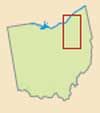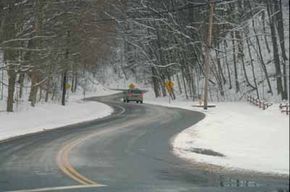The construction of the Ohio and Erie Canal in 1825 drastically changed the people and pace of this region, as did the Canalway Scenic Byway. Many byway visitors travel this route to learn about the development of the pre- and post-canal eras. The route also offers an impressive display of historical sites, along with many opportunities for hiking, biking, and water sports.
Archaeological Qualities of Canalway Ohio Scenic Byway
The CanalWay Ohio Scenic Byway boasts more than 500 archaeological sites; seven are listed on the National Register of Historic Places. One site, Irishtown Bend, is located in Cleveland Flats. This is where an early settlement of Irish canal workers lived. While visitors can't see very much at this site because the house foundations that have been semi-excavated have been covered up for protection, the findings at this site are significant.
Advertisement
Qualities of Canalway Ohio Scenic Byway
The influences on area culture can be classified into four elements: the resilience of farming communities, life during the canal period, the gumption of immigrants, and the accomplishments of wealthy industrialists.
Farming is still important to area culture, and the strength of past and present farmers is reflected in the sturdiness of the farms themselves: Many farms from the mid-19th century are still standing and working. The village of Zoar, which was founded in 1817 by a German religious sect, the Zoarites, is still working according to many of its old agricultural practices.
The sway of the canal era on area culture is apparent because its flavor is still potent in the historic cities of Clinton, Canal Fulton, Boston, and Peninsula.
The neighborhoods that immigrants developed retain their special foreign flavor, creating small pockets of spice along the byway. These National Register historic neighborhoods near Cleveland are based on Archwood-Dennison Avenue, Broadway Avenue, Ohio City, and Warszawa.
The ambitions of early wealthy industrialists are represented in the homes they built. Some of the more notable are the Stan Hywet Hall (Goodyear Rubber Company founder Frank A. Seiberling's home) and the Anna Dean Farm (Diamond Match founder O. C. Barber's estate).
Replete with continuous high-culture events, the larger cities on the route (Cleveland, Akron, Barberton, and Strongsville) retain several historic and well-known venues. The area's culture is manifested in locally produced festivals and entertainment.
Qualities of Canalway Ohio Scenic Byway
People have lived in the CanalWay Ohio area for nearly 12,000 years. The area was an important transportation route for American Indians, and it was deemed neutral territory so that all might travel safely from the cold waters of the Great Lakes to warmer southern waters. European explorers and trappers arrived in the 17th century, and immigrants slowly moved in to farm over the centuries. The modern catalyst for area development was the Ohio and Erie Canal, which gave way to the area's industrial era. The CanalWay Ohio Scenic Byway takes you through places that still show evidence of the early inhabitants and the effects of industrial development.
The countryside north of Dover consists of wooded ravines and hillsides. It is separated by tilled croplands and isolated farms. This setup comes from early settlement of the Pennsylvania Germans and the Moravians.

The newly constructed Indigo Lake Visitor Shelter is a stop on the old railroad. Here, visitors can fish in the adjacent lake, access the canal towpath, or walk to Hale Farm. This farm is a 19th-century farm, presented to visitors through a full program of living history.
Towns such as Dover, Bolivar, Navarre, Barberton, Canal Fulton, and Clinton show the influence of the canal with their early 19thcentury architecture, original canal-oriented street patterns, locks and spillways, and towpath trails along the historic canal route. Tours on the St. Helena III Canal Boat in Canal Fulton give visitors firsthand experience of canal life. The Canal Visitors Center is housed in an 1852 canal tavern.
Waters from the area's lakes provided the cooling needed for the industrial rubber boom, which created the prosperous Akron of the 1920s. Brick factories illustrate life in industrial-era Akron.
Qualities of Canalway Ohio Scenic Byway
The CanalWay Ohio Scenic Byway is a biological crossroad because it transects three regions: lake plains, glaciated plateau, and unglaciated plateau. This results in a great diversity of plants and animals, textbook examples of forest communities and habitats.
The primary trees in the glaciated plateau region are beech-maple (the most common), oak-hickory, and hemlock-beech. Ice Age hemlock-beech forests are found in ravines, while oak-hickories are found atop ridges and in drier areas. The Tinkers Creek Gorge National Landmark has a rare settlement of hemlock-beech on the moist valley floor.
Rolling hills and steep valleys characterize the unglaciated plateau region. Oak-hickory is common in this southern part of the route. Many of these lands are held and preserved by public agencies.
Qualities of Canalway Ohio Scenic Byway
There is plenty to do along the CanalWay Ohio Scenic Byway. Towpath Trail near the Ohio and Erie Canal is extremely popular; more than three million users enjoy the trail in a typical year. Other recreation includes skiing, golfing, picnicking, hiking, fishing, and boating, and water excursions are available along the rivers as well. Also, the route passes through several entertainment districts.
Find more useful information related to Ohio's Canalway Ohio Scenic Byway:
- Ohio Scenic Drives: Canalway Ohio Scenic Byway is just one of the scenic byways in Ohio. Check out the others.
- How to Drive Economically: Fuel economy is a major concern when you're on a driving trip. Learn how to get better gas mileage.
Advertisement













